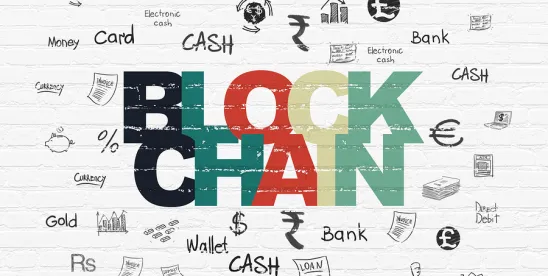The counterfeit business is booming. In fact, counterfeit goods account for a whopping 3.3% of global trade1 and cost the U.S. economy approximately $600 billion a year.2
The Dangers of Counterfeit Products
Counterfeiting has an extensive negative impact, leading to product recalls, lawsuits, consumer injuries, loss of sales, loss of consumer trust and, eventually, long-term reputational harm. Some of the most dangerous counterfeit products on the market today include counterfeit airbags that malfunction during car crashes, counterfeit lithium-ion batteries that self-ignite or explode, counterfeit helmets and baby carriers that easily break, counterfeit prescription drugs that cause accidental overdoses, and counterfeit cosmetics that cause severe skin reactions.3
Blockchain for Provenance
Blockchain helps tackle counterfeiting by identifying provenance (i.e., proof-of-origin) of a product, because blockchain provides a secure and trusted tracking system from one end of the supply chain (the creation or mining of raw materials) all the way to other end of the supply chain (where the end user enjoys the finished product). Because blockchain can identify provenance, legal enforcement agencies can more conclusively establish the counterfeit nature of suspect products, and companies can protect their bottom line.
Companies implement blockchain provenance identification through the use of smart tags, which when attached to a good will identify its place of manufacture, track its location, and assign other relevant information to it at each stage in the supply chain. Common types of smart tags include:
-
QR Codes. QR codes (Quick Response codes) are a type of barcode easily read by smart phones or tablets that can encode information like phone numbers or internet addresses.
-
RFID Tags. RFID tags (Radio Frequency Identification tags) are tags that use radio waves to communicate information to readers. A reader is a device that emits radio waves and subsequently receives signal back from an RFID tag.
-
Signatures on Metallic or Ceramic Surfaces. Laser marking machines etch barcodes and graphics onto metallic or ceramic surfaces. Some such marking machines produce 2D data matrix metal tags that users scan with a special scanner to perform data collection and product tracing functions.
Once a user affixes a product with a smart tag, the smart tag sends to the blockchain data for each new transaction with corresponding immutable time stamps. Therefore, at any point on the supply chain, a supply chain partner can trace that product back through the supply chain to see where and when such product originated.
While it would be practically difficult to accomplish, a scammer could create a counterfeit tag by duplicating a genuine smart tag. However, scanning that counterfeit tag would reveal the history of the genuine item, which would help a customer ascertain that the scanned tag is a counterfeit.4 For instance, if a leather purse with a counterfeit smart tag states the purse was sold by the distributor to ABC Purse Company for sale to the general public, yet the customer found the purse for sale at XYZ Purse Company, the customer could conclude that the smart tag was counterfeited.
Counterfeit Prevention by Industry
The prevalence of counterfeit products has dealt a heavy blow to the fashion, electronics, and pharmaceutical industries. Recognizing the importance of minimizing counterfeit product in the marketplace, leading companies are looking to blockchain to identify product provenance.
Fashion
High-value products that counterfeiters can reproduce swiftly for sale at a premium prove very vulnerable to counterfeiting. In 2019, Harvard Business Review reported that fake luxury merchandise accounted for 60 to 70% of all counterfeit goods sold annually and represented approximately a quarter of the $1.2 trillion total global trade in luxury goods.5
To protect its lines of luxury products on the market, the LVMH group, which boasts such brands such as Louis Vuitton and Bvlgari, partnered with two other luxury brands, Prada and Cartier, to develop the Aura Blockchain Consortium.6 The LVMH group unveiled the collaboration in April 2021, and describes it as the world’s first global luxury blockchain, which has the objective of providing consumers with the ability to trace a luxury product through its life cycle.7 The Aura Blockchain is a private blockchain engineered by ConsenSys, a software engineering pioneer in blockchain, and Microsoft.8
On the secondary market, blockchain provides a tool for verifying authenticity of fashion items. For instance, a retail store could use blockchain to record the identity of the original customer for a luxury purse sale, and a subsequent buyer could register with the blockchain to record the purse sale to another downstream buyer. The decrease in resale value that may result from a break in the chain of traceability may incentivize downstream buyers to register their ownership on the blockchain.
Moreover, blockchains can maintain or grow product value over time because consumers can verify product authenticity without the need for expert assistance. By using a proper blockchain construct, luxury brand companies can produce product that consumers can authenticate without the use of the luxury company’s internal company resources. Smart contracts programmed into blockchain can also automatically execute downstream transactions and provide compensation to producers and prior owners for the resale of a product.
Pharmaceuticals
Counterfeit drugs often look exactly like real drugs, with the same branding and packaging. Yet, the fake drugs can be contaminated or ineffective. Merck KGaA reported that counterfeit antimalarial drugs alone could be responsible for the deaths of up to 155,000 children annually.10
In response to the FDA’s call in 2019 for companies to create pilot projects to test electronic inter-operable systems, two dozen companies in the pharmaceutical industry, ranging from drug makers (including Pfizer Inc. and Eli Lilly and Company), to distributors and retailers, developed a blockchain platform named MediLedger Network to track prescription drugs around the globe in hopes of eliminating counterfeit medicines.11
Electronics
Identifying counterfeit products in a supply chain proves difficult, because counterfeiters package the counterfeit products to appear legitimate and because the counterfeit products often function adequately for at least some period of time. Additionally, because many electronic products end up as internal components in other devices, downstream consumers could find it difficult to detect knockoff parts. Failure to detect counterfeit electronics in the supply chain creates a risk for product malfunction, which could lead to injury or death.
As a result, Honeywell has partnered with iTRACE and SecureMarking to increase the security of the e-commerce market of its aerospace parts using blockchain technology.12 Honeywell’s new process involves laser-etching a data matrix on the identification plate for a part and then adding a high-security invisible ink on top of the plate. Honeywell’s digital blockchain ledger records the digital authenticity record for the part, allowing Honeywell to secure, track, trace and authenticate any part submitted to Honeywell’s blockchain process anywhere in the world.
Financial Benefits
In 2019, BCG, a consulting firm for business strategy, calculated that, by implementing blockchain-enabled authentication of products, businesses could reap financial benefits ranging from 2% to 5% of revenues.13 For example, electronics and technology companies lose somewhere in the realm of 4-7% of revenue to counterfeit products on an annual basis.14 If the same electronics and technology companies were to implement blockchain solutions paired with smart tag technology, these companies could reduce fraudulent sales by 60-80%, therefore allowing manufacturers to recoup an average of 3.85% in revenue.15 This translates into almost $40 million in savings for a $1 billion electronics company.16
However, blockchain solutions for counterfeit prevention may not be the appropriate solution for every manufacturer. Factors to consider before implementing a blockchain solution include the value of the target product, the size and complexity of the supply base, and the level of counterfeiting occurring with respect to the product at issue.17 Companies contemplating the launch of a blockchain system to combat counterfeiting should perform a careful analysis to determine whether the financial benefits of tracking with blockchain outweigh the costs and challenges of implementing the blockchain technology.
1 Sularia, Sanjeev, The Counterfeit Problem and how Retailers Can Fight Back in 2020, Forbes (March 17, 2020).
2 Schlesinger, Jennifer and Andrea Day, Here’s how the Trade War could Lead to a Boom in Counterfeit Goods, CNBC (March 13, 2019).
3 Counterfeit Goods: A Danger to Public Safety, U.S. Immigration and Customs Enforcement (last retrieved August 9, 2021).
4 Akash Bhatia et al., Stamping Out Counterfeit Goods with Blockchain and IoT, BCG (May 17, 2019).
5 Roberto Fontana et al., How Luxury Brands Can Beat Counterfeiters, Harvard Business Review (May 24, 2019).
6 LVMH Partners with Other Major Luxury Companies on Aura, the First Global Luxury Blockchain, LVMH (April 20, 2021).
7 Id.
8 Id.
9 Aura (last retrieved August 16, 2021).
10 Blockchain: A New Security Check for Medicines, Merck KGaA, (last retrieved August 16, 2021).
11 Gertrude Chavez-Dreyfuss, Companies in Pharmaceutical Supply Chain Develop System to Track Counterfeit Drugs, Reuters (February 21, 2020).
12 Honeywell, iTrace and SecureMarking Combat Counterfeit Activity in Aerospace with Blockchain, Honeywell (December 16, 2019).
13 Supra, note 4.
14 Id.
15 Id.
16 Id.
17 Id.






 />i
/>i

